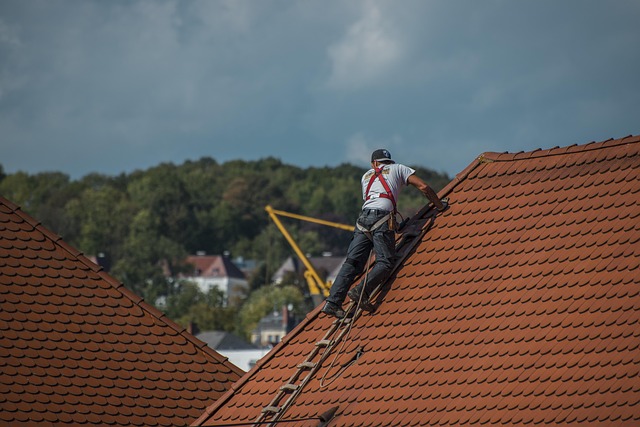-
Re-roofing protects your home from leaks, weather damage, and structural issues. It involves inspecting the roof, choosing the right materials, and replacing or adding new shingles.
-
Costs depend on materials, roof size, and necessary repairs. The process includes removing old materials, installing new layers, and ensuring proper ventilation.
-
Hiring a licensed contractor guarantees quality work, permits, and a smooth installation.
You don’t think about your roof every day. But when you spot missing shingles or a leak that stains your ceiling, it becomes impossible to ignore. A damaged roof doesn’t just affect how your home looks—it puts everything inside at risk.
Re-roofing isn’t just about fixing problems. It’s about making sure your home stays safe, dry, and strong for years. Whether your roof is aging or storm damage has taken its toll, understanding the re-roofing process helps you make the best decision.
What Is Re-roofing?
Re-roofing means adding a new layer of shingles or replacing the entire roof. It fixes damage, improves protection, and extends the roof’s lifespan. Some homes need a full replacement, while others only need new shingles over the old ones. The right approach depends on the roof’s condition.
Signs That Show You Need a New Roof
Roofs do not last forever. Over time, they weaken due to weather, aging, and regular wear. Replacing a roof at the right time helps avoid serious problems inside the home.
Shingles Are Curling, Cracking, or Missing
Shingles protect your home from rain, wind, and snow. When they start to curl or crack, they stop doing their job. Missing shingles leave gaps where water can enter. Even a few damaged shingles can lead to bigger problems.
Water Stains on Ceilings or Walls
Leaks start small, but they get worse over time. If you notice brown spots or streaks on ceilings and walls, the roof may not be keeping out moisture. Ignoring leaks can cause mold, wood rot, and other costly issues.
Moss, Algae, or Dark Streaks
If you see green patches or dark streaks on the roof, moisture is collecting on the surface. Moss and algae hold water against the shingles, making them weaker. Over time, this can lead to decay and roof failure.
Sagging or Drooping Roof
A sagging roof means there may be damage beneath the surface. Water might have soaked into the wood, weakening the structure. If the roof looks uneven or dips in certain areas, it needs attention right away.
Roof Age and Material Lifespan
Different roofing materials last for different periods. Asphalt shingles, which are common in many homes, last about 20 to 30 years. Metal and tile roofs last longer, but they still need replacement at some point. If the roof is old, it may be time to install a new one before problems start.
Choosing the Right Roofing Material

New Jersey weather changes throughout the year. Summers bring heat and humidity. Winters come with snow and freezing temperatures. Heavy rain and storms are common. The right roofing material should handle these conditions while fitting your budget and home’s design.
Common Roofing Materials
Choosing the right material is important. Each type has different costs, durability, and maintenance needs. Some materials last longer, while others are more affordable. Let’s look at some popular choices:
- Asphalt Shingles: These are the most common. They are affordable and easy to install. They come in different styles and colors. They work well in most weathers but may not last as long as other materials.
- Metal Roofing: This is strong and long-lasting. It holds up well against heavy snow, rain, and fire. It also reflects heat, which helps keep homes cooler in summer. Metal roofs cost more than asphalt but need less maintenance.
- Wood Shingles or Shakes: These give homes a natural and classic look. They require regular care to prevent mold and rot. They handle cold weather well but are not the best choice in areas with a lot of moisture.
- Tile Roofing: They resist fire, wind, and heat. They are heavy, so the roof must be strong enough to support them. This option costs more but lasts longer than asphalt.
- Slate Roofing: This is one of the longest-lasting materials. A slate roof can last over 100 years. It is expensive but adds value to a home. It is also very heavy, so the roof must be built to hold its weight.
The Re-roofing Process
Now you know when to reroof and what materials to choose. The next step is understanding how the process works. Re-roofing involves several stages, from inspection to final cleanup. Each step guarantees the roof stays strong and protects the home for years.
Inspection and Planning
A professional roofer checks for damage before starting any work. They look at shingles, flashing, and the roof deck. If shingles are curling, missing, or cracked, they may need to be replaced. Roofers also check for water damage inside the attic. Stains, mold, or a musty smell suggest moisture is getting through.
Once the inspection is complete, the roofer explains the options. Some roofs need a full replacement, while others only require a new layer of shingles. The type of material, budget, and local building codes also play a role in deciding the best approach.
Removing the Old Roof
If a full replacement is necessary, the old roofing materials must come off. Workers strip away shingles, nails, and underlayment. This step exposes the roof deck, revealing any hidden problems. Soft or rotting wood must be replaced to create a solid base for the new roof.
Tearing off an old roof creates a lot of debris. Professional roofers use tarps to protect landscaping and nearby areas. Dumpsters or trucks help remove waste quickly, keeping the worksite clean.
Installing the New Roof
Workers start at the lowest point and move upward. Each layer must overlap properly to keep water out. Shingles, metal panels, or tiles get nailed down securely. Edges and ridges receive special attention to improve durability.
Ventilation also plays a role in the installation. Proper airflow prevents heat and moisture buildup in the attic, which helps the roof last longer. Ridge vents, soffit vents, or fans may be part of the design.
Cleanup and Final Inspection
Once the roofing work is done, the cleanup begins. Workers remove debris, nails, and leftover materials. A magnet sweeper helps find stray nails in the yard and driveway.
Before finishing the job, roofers perform a final inspection. They check for loose shingles, proper sealing, and complete flashing installation. A well-installed roof should protect the home for decades without major problems.
Cost of Re-roofing
Re-roofing costs change based on materials, labor, and the condition of the current roof. Some roofs cost more because they need extra repairs or special installation methods. Getting estimates from different contractors helps find the best deal.
Factors That Affect Cost
Here are the main factors that determine how much re-roofing will cost.
- Material Choice: Roofing materials affect the price. Asphalt shingles cost less, while metal, tile, and slate cost more. Some materials last longer but come with higher upfront costs.
- Roof Size and Slope: Larger roofs need more materials and labor. Steep roofs take longer to work on and require extra safety equipment. These factors increase labor costs.
- Removal of Old Roof: Removing multiple layers takes more time and effort. Some homes need a full tear-off, while others allow a new layer of shingles over the existing one. More work leads to higher costs.
- Repairs Needed: Water damage and rotted wood increase costs. Roofers must fix these issues before installing new materials. Widespread damage raises the final price.
Common Questions Before Re-roofing
Many homeowners have concerns before starting a roofing project. Here are some common questions and their answers.
How Long Does Re-roofing Take?
Most re-roofing projects take between two to five days. The exact time depends on the size of the roof, the materials used, and any repairs needed.
A simple roof with asphalt shingles may be done in two days. A larger home or a roof with complex designs may take a week. Bad weather or unexpected damage can also cause delays.
Can I Stay in My Home During Re-roofing?
Yes, but expect a lot of noise. Roofers use hammers, nail guns, and heavy equipment. Walking on the roof also causes vibrations inside the house. If you work from home or have small children, the noise might be disruptive. Pets can also get anxious. Some homeowners choose to stay elsewhere for a few days until the work is done.
What Happens If It Rains During the Process?
Roofers check the weather before starting. If unexpected rain happens, they use tarps and waterproof covers to protect the exposed areas. A professional team will not remove the old roof unless the forecast is clear. If rain delays the project, work resumes once it is safe.
Do I Need a Permit for Re-roofing?
Most towns and cities require a permit for re-roofing. Contractors usually handle this process. They submit paperwork and schedule inspections as needed. If you hire a professional roofer, they will take care of the permits. If you are unsure, check with your local building department.
How Do I Choose the Right Contractor?
Not all roofing companies offer the same level of service. Look for a licensed and insured contractor with good reviews. Ask for references from past customers. Compare at least three estimates to understand pricing. A written contract should outline costs, materials, timelines, and warranties. Avoid companies that ask for full payment upfront or give vague answers.
Is it time to reroof your home? At DSK Roofing, we handle everything from start to finish, making the process smooth and hassle-free. We use top-quality materials, ensure expert installation, and back our work with solid warranties. Contact us today for a free consultation and take the first step toward a stronger, safer roof!

